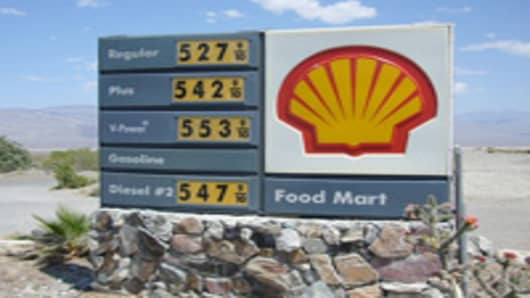I decided to conduct a little experiment, which you can see in the video clip below.
Gas prices have gotten so expensive it costs more to fuel your car than to fuel your body. My family is spending $150 a week on gasoline, A WEEK, and that is more than I spend on groceries. One reason for this disparity is that food suppliers are offering steep discounts as "loss leaders" during these tough times.
Fast food outlets are trying to lure in cash-strapped consumers with dollar menus. Grocery stores are sending out more coupons and providing steeper discounts to people with store-branded loyalty cards (at Fresh&Easy yesterday I saw strawberries for 95 cents! A 12-pack of beer for $5!!). Their hope, of course, is that you come in to buy the cheap stuff, then end up also buying higher-margin items.
But if you're very creative, you can eat on the cheap. Really cheap. I proved it.
I took $4.60, the price of a gallon of gasoline in Los Angeles, and managed to get three meals out of it, with $.93 left over.
Breakfast--McDonald's sausage burrito and (free) ice water: $1.08
Lunch--Taco Bell triple nachos and (free) ice water: $.86
Dinner--Hormel Turkey Chili, Yoplait Yogurt, Plum and tap water: $1.73 at Kroger-owned Ralph's using loyalty card.
Total: $3.67
Did anyone make money off me in this experiment? Probably not. McDonaldsfranchisees are reportedly complaining that they don't want to promote the dollar menu because they want to encourage people to buy more profitable items. I bought the raw materials at the grocery store (not wholesale) for the breakfast and lunch meals, and portioning out what I would use for a sausage burrito and some nachos, the cost was 60 cents more than what I actually paid for them at the fast food chains.
Those chains not only have food costs to cover, but also labor, energy, etc. On the grocery side, the dinner I bought at Ralph's would have cost $4.17 without the loyalty card, a full $2.44 more than what I paid, so that gives you some idea of what normal margins are.
Assuming I ate "loss leaders" all day and the stores made no profit on me, what kind of profit would the oil industry make off me if I had bought a gallon of gas with that same money? That is really hard to determine. I can't get a straight answer anywhere.But on this website from the U.S. Energy Information Administrationyou can at least see how the average gallon of gas is divvied up: 58 percent of the price covers the cost of the crude, 17 percent is for refining costs and profits, 15 percent goes to state and federal taxes, and 10 percent goes to marketing and distribution.
I think the most interesting thing to me about the experiment was this: I was worried I'd starve, but I actually felt full most of the day. It reminded me of being back in college when I lived on ramen and peanut butter sandwiches. Hey, I lived.



